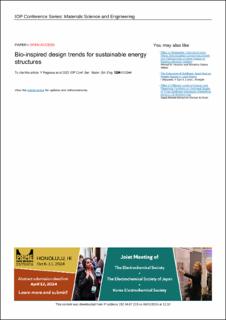| dc.contributor.author | Regassa, Yohannes | |
| dc.contributor.author | Dabasa, T. | |
| dc.contributor.author | Amare, G. | |
| dc.contributor.author | Lemu, Hirpa G. | |
| dc.date.accessioned | 2024-02-06T14:10:12Z | |
| dc.date.available | 2024-02-06T14:10:12Z | |
| dc.date.created | 2024-01-03T07:50:16Z | |
| dc.date.issued | 2023 | |
| dc.identifier.citation | Regassa, Y., Dabasa, T., Amare, G. & Lemu, H.G. (2023) Bio-inspired design trends for sustainable energy structures. IOP Conference Series: Materials Science and Engineering, 1294, 012044 | en_US |
| dc.identifier.issn | 1757-8981 | |
| dc.identifier.uri | https://hdl.handle.net/11250/3115992 | |
| dc.description.abstract | Researchers and engineers are constantly looking to nature for design inspiration as they work to create novel and effective energy conversion structures. Engineers are developing durable and resilient materials to survive extreme weather conditions and environmental issues using inspiration from the Nenuphar's durability in adverse aquatic environments and the Sunflower's adaptation to vary climatic situations. The analysis of new design ideas in renewable energy systems in this research was inspired by the Nenuphar (Water Lily) and the Sunflower. The Nenuphar's exceptional capacity to float and large leaf surface make it a model for enhanced water-based energy conversion systems. Researchers have been looking into novel concepts like floating solar farms and wave energy collecting platforms after being inspired by the Nenuphar's buoyancy and ability to efficiently use sunlight. Solar panel integration with water features can boost overall energy output while preserving precious land resources. The Sunflower, known for its phototropism and effective sun-tracking mechanism, offers suggestions for improving solar energy harvesting. Advanced heliotropic solar panels have demonstrated promising results in boosting energy production throughout the day by mimicking the Sunflower's ability to follow the trajectory of the Sun. These designs maximize energy outputs and boost overall system efficiency by maximizing solar exposure. Embracing these bio-inspired concepts can lead to the development of sustainable and efficient energy solutions, contributing to a greener and more sustainable future. Furthermore, the integration of smart technology and artificial intelligence is on the rise to optimize energy conversion structures. | en_US |
| dc.language.iso | eng | en_US |
| dc.publisher | IOP Publishing | en_US |
| dc.rights | Navngivelse 4.0 Internasjonal | * |
| dc.rights.uri | http://creativecommons.org/licenses/by/4.0/deed.no | * |
| dc.title | Bio-inspired design trends for sustainable energy structures | en_US |
| dc.type | Peer reviewed | en_US |
| dc.type | Journal article | en_US |
| dc.description.version | publishedVersion | en_US |
| dc.subject.nsi | VDP::Teknologi: 500 | en_US |
| dc.source.volume | 1294 | en_US |
| dc.source.journal | IOP Conference Series: Materials Science and Engineering | en_US |
| dc.identifier.doi | 10.1088/1757-899X/1294/1/012044 | |
| dc.identifier.cristin | 2219474 | |
| dc.source.articlenumber | 012044 | en_US |
| cristin.ispublished | true | |
| cristin.fulltext | original | |
| cristin.qualitycode | 1 | |

